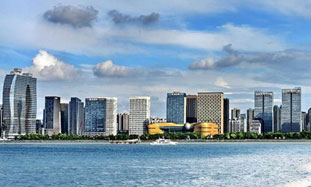Zhejiang announces water conservation plan
East China's Zhejiang province recently released a government document regarding the launch of a water conservation campaign throughout the province, as the government seeks to turn the province into a leader in the nation's drive to conserve water.
"In fact, Zhejiang is relatively lacking in water supply by international standards," said Feng Qiang, deputy director of the Zhejiang provincial department of water resources. The province's average water reserves were 97.6 billion cubic meters over the past few years, and its per capita water reserves were 1,702 cubic meters per year, around 20 percent lower than the national average and only one quarter of the global average.
Zhejiang is also suffering from an unbalanced distribution of water resources. Rainfall is concentrated between June and August, during which 70 percent of the water directly flows into the sea in raging floods without being effectively utilized. Droughts often occur during autumn and winter due to a scarcity of rainfall. On top of this, the province's two most populous and prosperous areas, namely the Hangzhou-Jiaxing-Huzhou region and the Ningbo-Shaoxing region, contribute two thirds of the province's GDP while being home to only one fifth of the province's water resources, and are facing an increasingly severe water shortage as a result.
In 2018, every $10,000 of GDP created in Zhejiang consumed 254 cubic meters of water; the corresponding numbers for Japan and Singapore are 136 and 23 cubic meters respectively. A region's efficiency in water usage reflects its overall industrial structure, technological level, and water treatment capabilities. "Therefore, advocating for the economical use of water is a necessity for us in our pursuit of high-quality development," Feng said.
According to the government document, Zhejiang plans to cut water consumption per $10,000 of GDP by at least 42 percent by 2022, compared with the level in 2015.
The province will focus on six major areas: conserving water in the agricultural and industrial sectors, preventing water waste in urban areas, utilizing irregular waters, setting up benchmarks, and manufacturing water-saving equipment.
Construction on a series of seawater desalination projects is about to get underway on several large islands, aiming to raise the province's seawater desalination capacity to 400,000 cubic meters per day by 2022 so as to meet the water consumption demands of islands.

 Print
Print Mail
Mail
 20 Cultural Symbols
20 Cultural Symbols Why Zhejiang
Why Zhejiang Experiencing high-tech products at WIC
Experiencing high-tech products at WIC Zhejiang Release
Zhejiang Release Zhejiang News
Zhejiang News